Effects of Clostridium butyricum on Intestinal Microflora and Metabolism of Eriocheir sinensis
Abstract
:1. Introduction
2. Results
2.1. Effect of C. butyricum on Serum Antioxidant Capacity of E. sinensis
2.2. Effects of C. butyricum on Antioxidant Capacity of Hepatopancreas in E. sinensis
2.3. Effects of C. butyricum on Intestinal Tissue of E. sinensis
2.4. Effects of C. butyricum on Intestinal Flora of E. sinensis
2.4.1. Sequencing Data Quality Analysis
2.4.2. Intestinal Microbial Dilution Curve
2.4.3. Analysis of Alpha Diversity of Intestinal Flora of E. sinensis by C. butyricum
2.4.4. Analysis of Bate Diversity of Intestinal Flora of E. sinensis by C. butyricum
2.4.5. Effects of C. butyricum on Intestinal Flora Composition of E. sinensis
2.4.6. Statistical Analysis of Microbial Multivariate Variables
2.5. Effects of C. butyricum on Intestinal Flora Metabolism of E. sinensis
2.5.1. Sample Raw Data and Principal Component Analysis
2.5.2. Screening of Differential Metabolites
2.5.3. Significant Differential Metabolites
2.5.4. Enrichment Analysis of Metabolic Pathways
2.6. Joint Analysis of Metabolomics and High-Throughput Sequencing
3. Discussion
3.1. Effects of C. butyricum on Blood and Liver Antioxidant Capacity of E. sinensis
3.2. Effects of C. butyricum on Intestinal Tissue of E. sinensis
3.3. Effects of C. butyricum on Intestinal Flora of E. sinensis
3.4. Effects of C. butyricum on Intestinal Flora Metabolism of E. sinensis
4. Materials and Methods
4.1. Strain and Feed Preparation
4.2. Laboratory Animal
4.3. Determination of Serum Antioxidant Capacity
4.4. Determination of Digestive Enzymes and Antioxidant Capacity of Hepatopancreas
4.5. Observation on Intestinal Morphology of E. sinensis
4.6. Determination of Intestinal Flora of E. sinensis
4.6.1. Sample Collection
4.6.2. Total DNA Extraction and PCR Amplification of Intestinal Flora
4.6.3. Purification and Quantification of PCR Products
4.6.4. Sequencing Data Processing and Analysis of Intestinal Microorganisms
4.7. Study on the Metabolomics of Intestinal Flora
4.7.1. Sample Pretreatment
4.7.2. Chromatographic Mass Spectrometry Conditions
4.8. Analysis of Data
5. Conclusions
Supplementary Materials
Author Contributions
Funding
Institutional Review Board Statement
Informed Consent Statement
Data Availability Statement
Conflicts of Interest
References
- Gu, X.; Zhao, F. Resources and Culturing Situation of Chinese Mitten Crab (Eriocheir sinensis) and Species Character Conservation. J. Lake Sci. 2001, 03, 267–271. [Google Scholar]
- Ding, Z. Current Disease Threats for Cultivated Crab Eriocheir sinensis in China. Transbound. Emerg. Dis. 2023, 2023, 3305963. [Google Scholar] [CrossRef]
- Luis Balcazar, J.; Rojas-Luna, T.; Cunningham, D.P. Effect of the addition of four potential probiotic strains on the survival of pacific white shrimp (Litopenaeus vannamei) following immersion challenge with Vibrio parahaemolyticus. J. Invertebr. Pathol. 2007, 96, 147–150. [Google Scholar] [CrossRef]
- Wang, Y.-B.; Li, J.-R.; Lin, J. Probiotics in aquaculture: Challenges and outlook. Aquaculture 2008, 281, 1–4. [Google Scholar] [CrossRef]
- Wan, J.-J.; Pan, J.-L.; Shen, M.-F.; Xue, H.; Sun, M.-L.; Zhang, M.-Q.; Zhu, X.-H.; Ma, X.-K. Changes in the growth performance, antioxidant enzymes and stress resistance caused by dietary administration of synbiotic (fructooligosaccharide and probiotics) in juvenile Chinese Mitten Crab, Eriocheir sinensis. Aquac. Int. 2022, 30, 467–481. [Google Scholar] [CrossRef]
- Zhang, C.; Hou, T.; Yu, Q.; Wang, J.; Ni, M.; Zi, Y.; Xin, H.; Zhang, Y.; Sun, Y. Clostridium butyricum improves the intestinal health of goats by regulating the intestinal microbial community. Front. Microbiol. 2022, 13, 991266. [Google Scholar] [CrossRef] [PubMed]
- Peng, X.; Tian, Y.; Ma, X.; Ge, J.; Huang, Y. Effect of Clostridium butyricum on antioxidant, immunity function and digestive ability of Eriocheir sinensis juveniles. Feed Res. 2023, 46, 55–58. [Google Scholar]
- Cao, H.; Huang, X.; Gu, Y.; Zheng, X.; Xu, L.; Gai, C. Protective effects of Bacillus licheniformis against Citrobacter freundii infection in Chinese mitten crab Eriocheir sinensis. J. Invertebr. Pathol. 2022, 193, 107805. [Google Scholar] [CrossRef]
- Fu, J.; Li, L.; Liu, J.; Liao, T.; Tie, Y.; Wen, X. Research progress in the application of Clostridium butyricum and its metabolites in food processing. Food Ferment. Ind. 2020, 13, 293–298. [Google Scholar]
- Ma, L.; Shen, Q.; Lyu, W.; Lv, L.; Wang, W.; Yu, M.; Yang, H.; Tao, S.; Xiao, Y. Clostridium butyricum and Its Derived Extracellular Vesicles Modulate Gut Homeostasis and Ameliorate Acute Experimental Colitis. Microbiol. Spectr. 2022, 10, e01368-22. [Google Scholar] [CrossRef]
- Nicholson, J.K.; Wilson, I.D. Understanding ‘global’ systems biology: Metabonomics and the continuum of metabolism. Nat. Rev. Drug Discov. 2003, 2, 668–676. [Google Scholar] [CrossRef]
- Liu, C.; Zhao, L.-P.; Shen, Y.-Q. A systematic review of advances in intestinal microflora of fish. Fish Physiol. Biochem. 2021, 47, 2041–2053. [Google Scholar] [CrossRef]
- Wu, Y.; Yang, K.; Huang, X.; Zhou, C.; Xu, C.; Huang, Z.; Yu, W.; Xun, P.; Huang, J.; Mai, X.; et al. Effects of dietary Clostridium butyricum supplementation on growth performance and intestinal flora of juvenile Trachinotus ovatus. South China Fish. Sci. 2022, 18, 155–162. [Google Scholar]
- Duan, Y.; Wang, Y.; Dong, H.; Ding, X.; Liu, Q.; Li, H.; Zhang, J.; Xiong, D. Changes in the Intestine Microbial, Digestive, and Immune-Related Genes of Litopenaeus vannamei in Response to Dietary Probiotic Clostridium butyricum Supplementation. Front. Microbiol. 2018, 9, 2191. [Google Scholar] [CrossRef] [PubMed]
- Yuan, H.; Li, X.; Sun Qn Tan, X.; Su, Y.; Huang, Y.; Yin, W.; Zhou, M. Effects of Clostridium butyricum spores on growth performance, biochemical parameters in serum, intestinal flora and short-chain fatty acid content of Paneaus vannamei. J. South China Agric. Univ. 2023, 44, 212–220. [Google Scholar]
- Yamamoto, M.; Ohmori, H.; Takei, D.; Matsumoto, T.; Takemoto, M.; Ikeda, M.; Sumimoto, R.; Kobayashi, T.; Ohdan, H. Clostridium butyricum affects nutrition and immunology by modulating gut microbiota. Biosci. Microbiota Food Health 2022, 41, 30–36. [Google Scholar] [CrossRef] [PubMed]
- Li, P.; Hou, D.; Zhao, H.; Wang, H.; Peng, K.; Cao, J. Dietary Clostridium butyricum Improves Growth Performance and Resistance to Ammonia Stress in Yellow Catfish (Pelteobagrus fulvidraco). Aquac. Nutr. 2022, 2022, 6965174. [Google Scholar] [CrossRef]
- Zhu, J.; Wen, B.; Cheng, G.; Gao, J.; Chen, Z. Effects of Clostridium butyricum on growth, body index, nutrient utilization, and intestinal structure and function of discus fish Symphysodon haraldi. J. Fish. China 2023, 1–10. Available online: https://kns.cnki.net/kcms/detail//31.1283.S.20230227.1523.002.html (accessed on 31 July 2023).
- Rengpipat, S.; Rukpratanporn, S.; Piyatiratitivorakul, S.; Menasaveta, P. Immunity enhancement in black tiger shrimp (Penaeus monodon) by a probiont bacterium (Bacillus S11). Aquaculture 2000, 191, 271–288. [Google Scholar] [CrossRef]
- McCord, J.M.; Fridovich, I. Superoxide dismutase. An enzymic function for erythrocuprein (hemocuprein). J. Biol. Chem. 1969, 244, 6049–6055. [Google Scholar] [CrossRef]
- Yang, G.; Tian, X.; Dong, S.; Peng, M.; Wang, D. Effects of dietary Bacillus cereus G19, B-cereus BC-01, and Paracoccus marcusii DB11 supplementation on the growth, immune response, and expression of immune-related genes in coelomocytes and intestine of the sea cucumber (Apostichopus japonicus Selenka). Fish Shellfish. Immunol. 2015, 45, 800–807. [Google Scholar] [CrossRef] [PubMed]
- Shao, X.-P.; Liu, W.-B.; Xu, W.-N.; Lu, K.-L.; Xia, W.; Jiang, Y.-Y. Effects of dietary copper sources and levels on performance, copper status, plasma antioxidant activities and relative copper bioavailability in Carassius auratus gibelio. Aquaculture 2010, 308, 60–65. [Google Scholar] [CrossRef]
- Zhou, J.; Ao, X.; Lei, Y.; Ji, C.; Ma, Q. Bacillus subtilis ANSB01G culture alleviates oxidative stress and cell apoptosis induced by dietary zearalenone in first-parity gestation sows. Anim. Nutr. 2020, 6, 372–378. [Google Scholar] [CrossRef]
- Chelikani, P.; Fita, I.; Loewen, P.C. Diversity of structures and properties among catalases. Cell. Mol. Life Sci. 2004, 61, 192–208. [Google Scholar] [CrossRef] [PubMed]
- Wang, X.-J.; Hu, G.-C.; Zhang, L.i.-J.; Li, J.-Z.; Guo, S.; Liu, Y.; Gan, L.; Cui, K. Influence of cadmium on antioxidant defense system injuvenile of Orechromis niloticus. Mar. Environ. Sci. 2016, 35, 647–651+657. [Google Scholar]
- Sandamalika, W.M.G.; Kwon, H.; Lim, C.; Yang, H.; Lee, J. The possible role of catalase in innate immunity and diminution of cellular oxidative stress: Insights into its molecular characteristics, antioxidant activity, DNA protection, and transcriptional regulation in response to immune stimuli in yellowtail clownfish (Amphiprion clarkii). Fish Shellfish Immunol. 2021, 113, 106–117. [Google Scholar]
- Pan, J.-H.; Feng, L.; Jiang, W.-D.; Wu, P.; Kuang, S.-Y.; Tang, L.; Zhang, Y.-A.; Zhou, X.-Q.; Liu, Y. Vitamin E deficiency depressed fish growth, disease resistance, and the immunity and structural integrity of immune organs in grass carp (Ctenopharyngodon idella): Referring to NF-kappa B, TOR and Nrf2 signaling. Fish Shellfish Immunol. 2017, 60, 219–236. [Google Scholar] [CrossRef]
- Xu, M.; Zhang, J.; Huang, G.; Zhang, C.; Cheng, Y.; Yang, X. Effects of L-tryptophan and melatonin on the serum glucose level and antioxidant capacity in the hepatopancreas of Chinese mitten crab (Eriocheir sinensis). J. Fish. China 2018, 42, 91–99. [Google Scholar]
- Lei, Y.; Sun, Y.; Wang, X.; Lin, Z.; Bu, X.; Wang, N.; Du, Z.; Qin, J.; Chen, L. Effect of dietary phosphorus on growth performance, body composition, antioxidant activities and lipid metabolism of juvenile Chinese mitten crab (Eriocheir sinensis). Aquaculture 2021, 531, 735856. [Google Scholar] [CrossRef]
- Qin, M.-L.; Hey-Z; Tan, X.-Y.; Zhang, C.-Q.; Liu, Y.-Q.; Meng, L.-Q.; Tong, T.; Zhang, Q. Effect of Clostridium butyricum on growth performance, serum biochemical indexes and liver antioxidant indexes of juvenile tilapia. Feed Res. 2022, 45, 47–51. [Google Scholar]
- Zhang, C.; Wang, X.; Wang, C.; Song, Y.; Pan, J.; Shi, Q.; Qin, J.; Chen, L. Gamma-aminobutyric acid regulates glucose homeostasis and enhances the hepatopancreas health of juvenile Chinese mitten crab (Eriocheir sinensis) under fasting stress. Gen. Comp. Endocrinol. 2021, 303, 113704. [Google Scholar] [CrossRef] [PubMed]
- Wang, X.; Wang, L.; Zhang, H.; Liu, R.; Song, L. The carbohydrate metabolism of scallop Chlamys farreri in the immune response against acute challenge of Vibrio anguillarum. Aquac. Int. 2015, 23, 1141–1155. [Google Scholar] [CrossRef]
- Purushothaman, K.; Tan, J.K.H.; Lau, D.; Saju, J.M.; Thevasagayam, N.M.; Wee, C.L.; Vij, S. Feed Restriction Modulates Growth, Gut Morphology and Gene Expression in Zebrafish. Int. J. Mol. Sci. 2021, 22, 1814. [Google Scholar] [CrossRef] [PubMed]
- Huyben, D.; Chiasson, M.; Lumsden, J.S.; Pham, P.H.; Chowdhury, M.A.K. Dietary Microencapsulated Blend of Organic Acids and Plant Essential Oils Affects Intestinal Morphology and Microbiome of Rainbow Trout (Oncorhynchus mykiss). Microorganisms 2021, 9, 2063. [Google Scholar] [CrossRef] [PubMed]
- Liu, J.; Feng, X.; Zhang, Y.; Cao, J. Differences in Intestinal Morphology and Enzymatic Characteristics between Kio and Goldfish in Hybrid and Self-Crossed Offsptings. Fish. Sci. 2021, 40, 905–910. [Google Scholar]
- Soares, M.P.; Cardoso, I.L.; Araujo, F.E.; De Angelis, C.F.; Mendes, R.; Mendes, L.W.; Fernandes, M.N.; Jonsson, C.M.; de Queiroz, S.C.D.N.; Duarte, M.C.T.; et al. Influences of the alcoholic extract of Artemisia annua on gastrointestinal microbiota and performance of Nile tilapia. Aquaculture 2022, 560, 738521. [Google Scholar] [CrossRef]
- Ma, X.; Wu, X.; Hu, L. Effcets of Two Species of Dietary Viable Bacteria on Microbiota in Water and Intestinal of Juvenile Red Crucian Carp Carassius auratus. Fish. Sci. 2018, 37, 316–323. [Google Scholar]
- Li, K.; Guan, W.; Wei, G.; Liu, B.; Xu, J.; Zhao, L.; Zhang, Y. Phylogenetic analysis of intestinal bacteria in the Chinese mitten crab (Eriocheir sinensis). J. Appl. Microbiol. 2007, 103, 675–682. [Google Scholar] [CrossRef]
- Su, H.; McClarty, G.; Dong, F.; Hatch, G.M.; Pan, Z.X.K.; Zhong, G.M. Activation of Raf/MEK/ERK/cPLA2 signaling pathway is essential for chlamydial acquisition of host glycerophospholipids. J. Biol. Chem. 2004, 279, 9409–9416. [Google Scholar] [CrossRef]
- Anas, A.; Sukumaran, V.; Nampullipurackal Devarajan, D.; Maniyath, S.; Chekidhenkuzhiyil, J.; Mary, A.; Parakkaparambil Kuttan, S.; Tharakan, B. Probiotics inspired from natural ecosystem to inhibit the growth of Vibrio spp. causing white gut syndrome in Litopenaeus vannamei. 3 Biotech 2021, 11, 66. [Google Scholar] [CrossRef]
- Madani, N.S.H.; Adorian, T.J.; Farsani, H.G.; Hoseinifar, S.H. The effects of dietary probiotic Bacilli (Bacillus subtilis and Bacillus licheniformis) on growth performance, feed efficiency, body composition and immune parameters of whiteleg shrimp (Litopenaeus vannamei) postlarvae. Aquac. Res. 2018, 49, 1926–1933. [Google Scholar] [CrossRef]
- Smith, P.; Owen, D.M.; Lorenz, C.D.; Makarova, M. Asymmetric glycerophospholipids impart distinctive biophysical properties to lipid bilayers. Biophys. J. 2021, 120, 1746–1754. [Google Scholar] [CrossRef] [PubMed]
- Perrin-Cocon, L.; Agaugue, S.; Coutant, F.; Saint-Mezard, P.; Guironnet-Paquet, A.; Nicolas, J.F.; Andre, P.; Lotteau, V. Lysophosphatidylcholine is a natural adjuvant that initiates cellular immune responses. Vaccine 2006, 24, 1254–1263. [Google Scholar] [CrossRef] [PubMed]
- Nakano, T.; Raines, E.W.; Abraham, J.A.; Klagsbrun, M.; Ross, R. Lysophosphatidylcholine upregulates the level of heparin-binding epidermal growth factor-like growth factor mRNA in human monocytes. Proc. Natl. Acad. Sci. USA 1994, 91, 1069–1073. [Google Scholar] [CrossRef]
- Liu, H.; Fu, S.; Qiu, M.; Lin, M.; Wang, A.; Ye, J. The Effect of Lead (Pb) in Water on the Intestinal Structure and Function of Juvenile Grass Carp (Ctenopharyngodon idellus). J. South China Norm. Univ. 2019, 51, 61–68. [Google Scholar]
- Tingting, L.; Likun, R.; Dangfeng, W.; Minjie, S.; Qiuying, L.; Jianrong, L. Effect of allicin and its mechanism of action in purine removal in turbot. J. Food Sci. 2020, 85, 3562–3569. [Google Scholar]
- Wang, G.; Niu, X.; Lu, H.; Li, Z.; Han, Y.; Zhao, C. Effect of Dietary Energy and Vitamin B6 on Growth and Enzyme of Protein Metabolism in Channa argus. Acta Sci. Nat. Univ. Sunyatseni 2011, 50, 96–99+105. [Google Scholar]
- Hoseini, S.M.; Khan, M.A.; Yousefi, M.; Costas, B. Roles of arginine in fish nutrition and health: Insights for future researches. Rev. Aquac. 2020, 12, 2091–2108. [Google Scholar] [CrossRef]
- Yang, T.; Hui, R.; Nouws, J.; Sauler, M.; Zeng, T.; Wu, Q. Untargeted metabolomics analysis of esophageal squamous cell cancer progression. J. Transl. Med. 2022, 20, 127. [Google Scholar] [CrossRef]
- Liu, D.; Wang, J.; Zeng, H.; Zhou, F.; Wen, B.; Zhang, X.; Luo, Y.; Wu, W.; Huang, J.; Liu, Z. The metabolic regulation of Fuzhuan brick tea in high-fat diet-induced obese mice and the potential contribution of gut microbiota. Food Funct. 2022, 13, 356–374. [Google Scholar] [CrossRef]
- Zhao, L. UPLC-Q/TOF MS Analysis of GP Metabolism in RAW264.7 Cell Inflammation Model Interfering by NSAIDs. Master’s Thesis, Guangdong Pharmaceutical University, Guangzhou, China, 2012. [Google Scholar]
- Callahan, B.J.; McMurdie, P.J.; Rosen, M.J.; Han, A.W.; Johnson, A.J.A.; Holmes, S.P. DADA2: High-resolution sample inference from Illumina amplicon data. Nat. Methods 2016, 13, 581–583. [Google Scholar] [CrossRef] [PubMed]
- Bolyen, E.; Rideout, J.R.; Dillon, M.R.; Bokulich, N.A.; Abnet, C.C.; Al-Ghalith, G.A.; Alexander, H.; Alm, E.J.; Arumugam, M.; Asnicar, F.; et al. Reproducible, interactive, scalable and extensible microbiome data science using QIIME 2. Nat. Biotechnol. 2019, 37, 1091. [Google Scholar] [CrossRef] [PubMed]
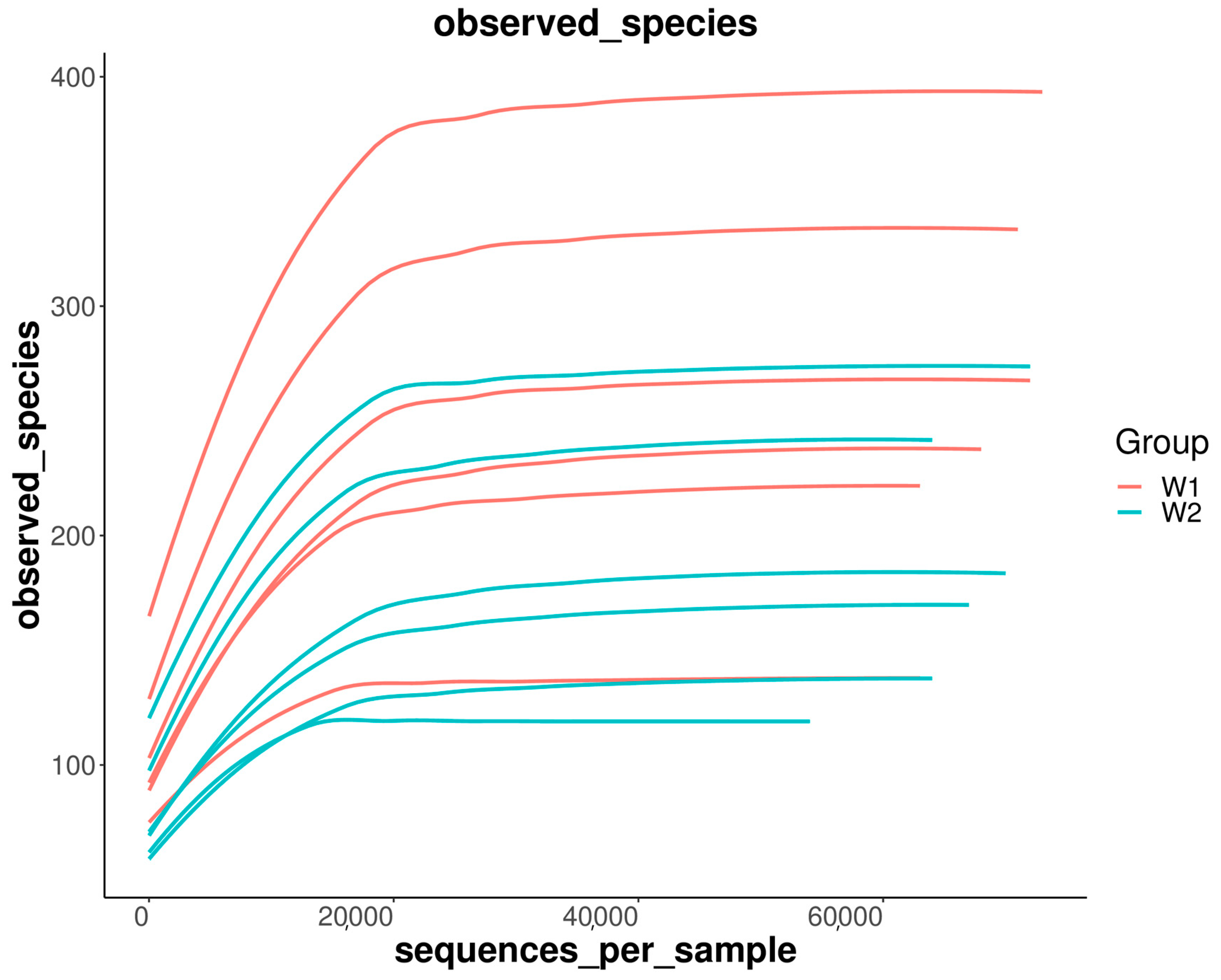
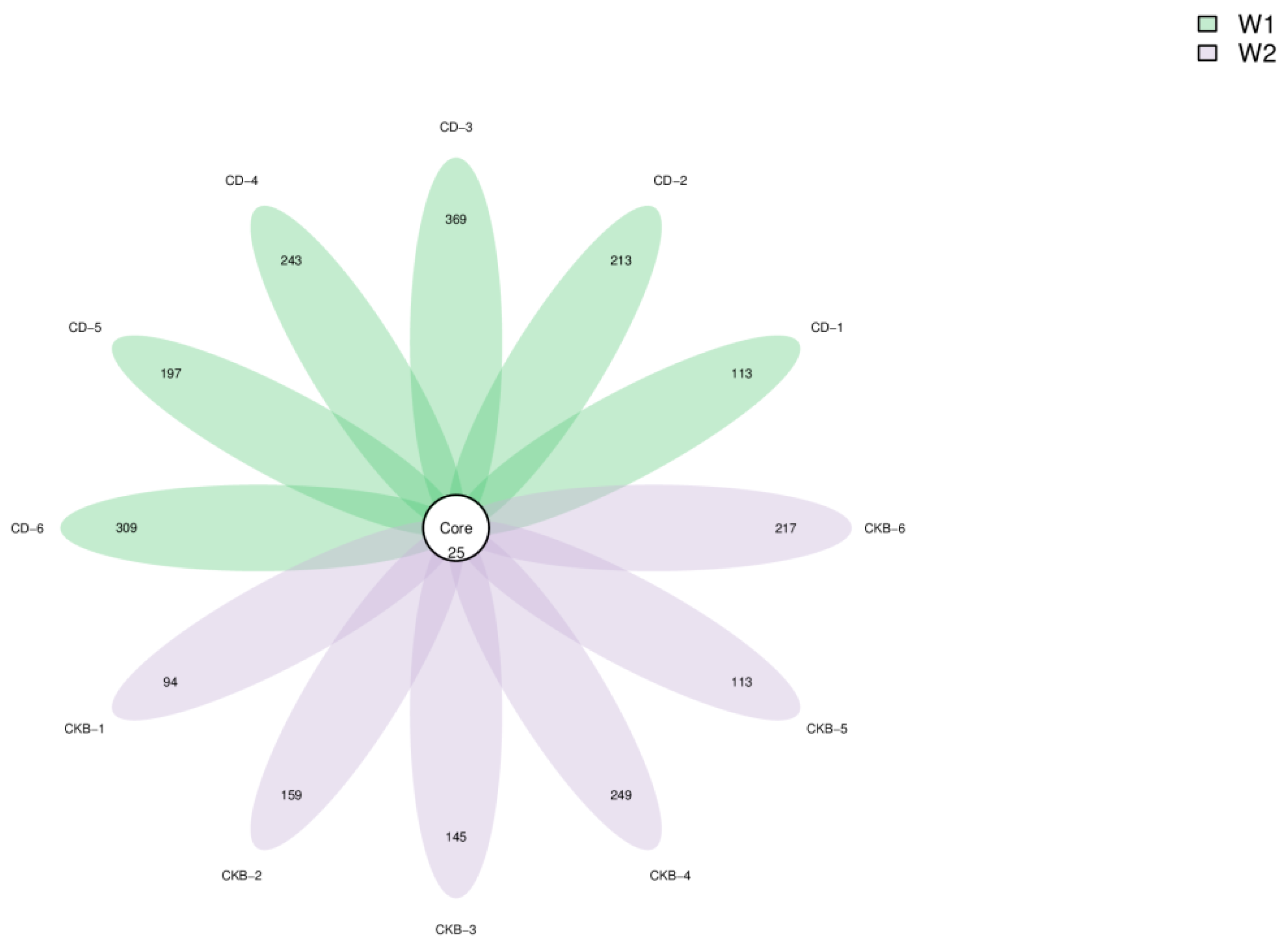
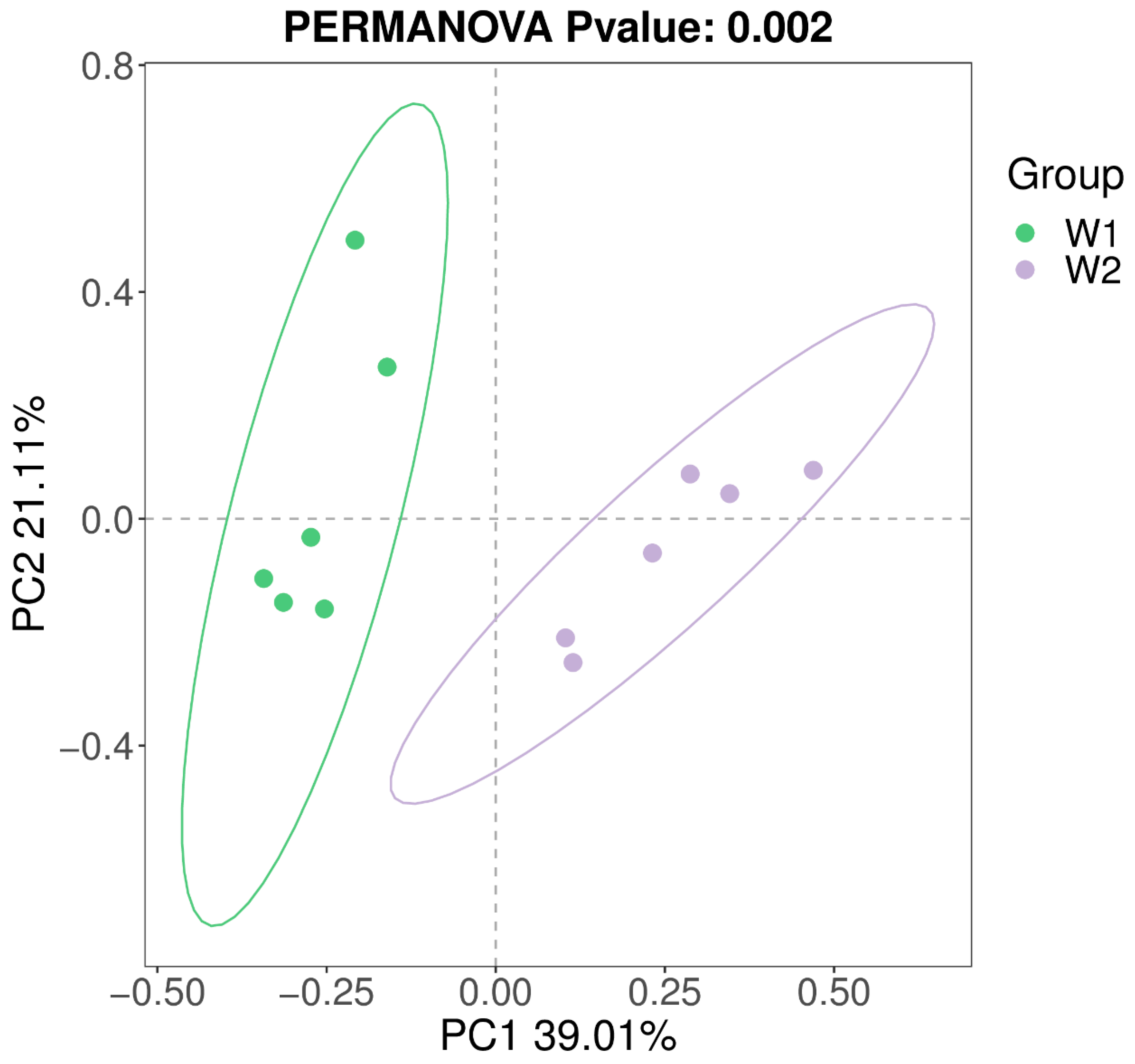
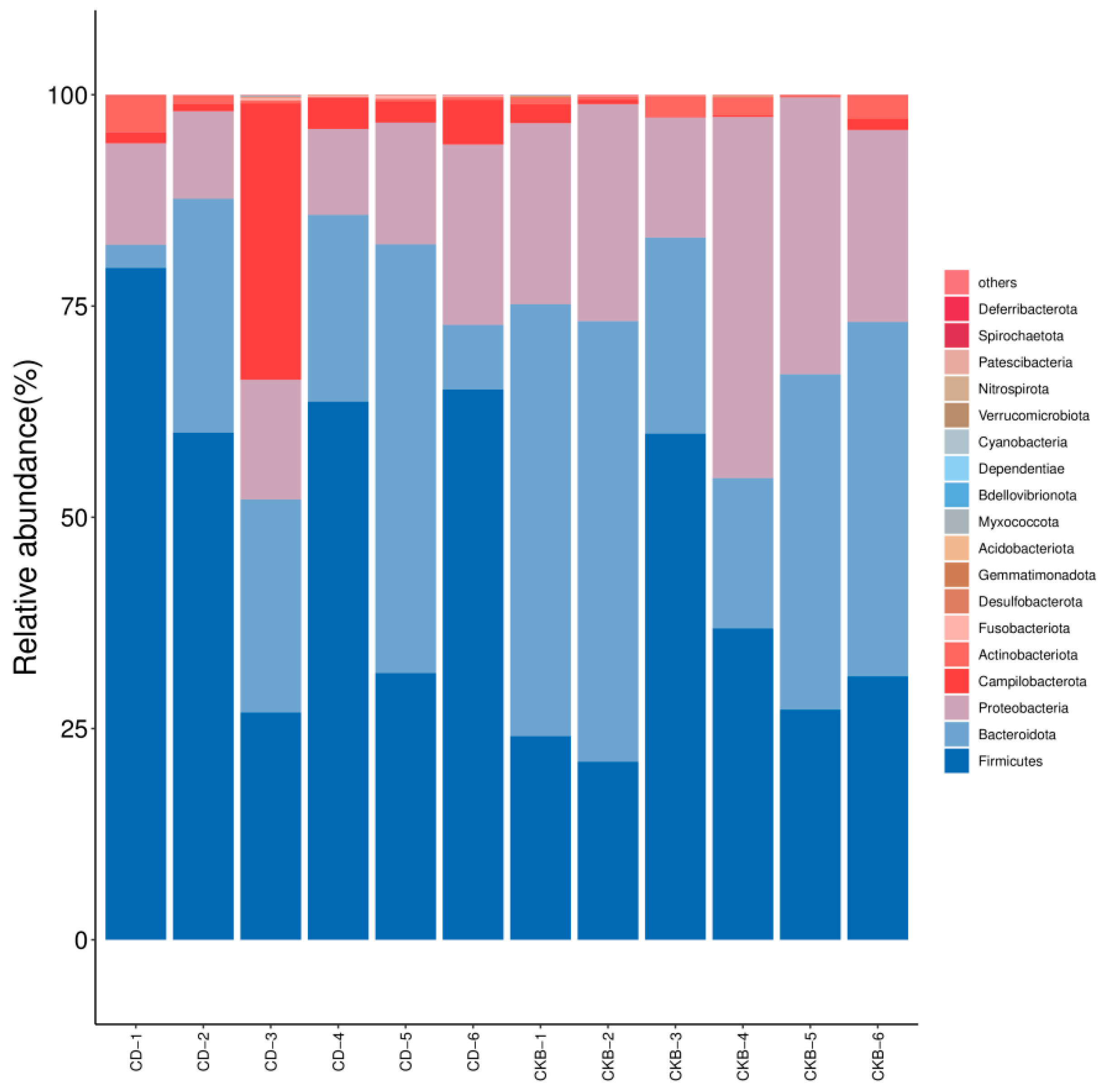
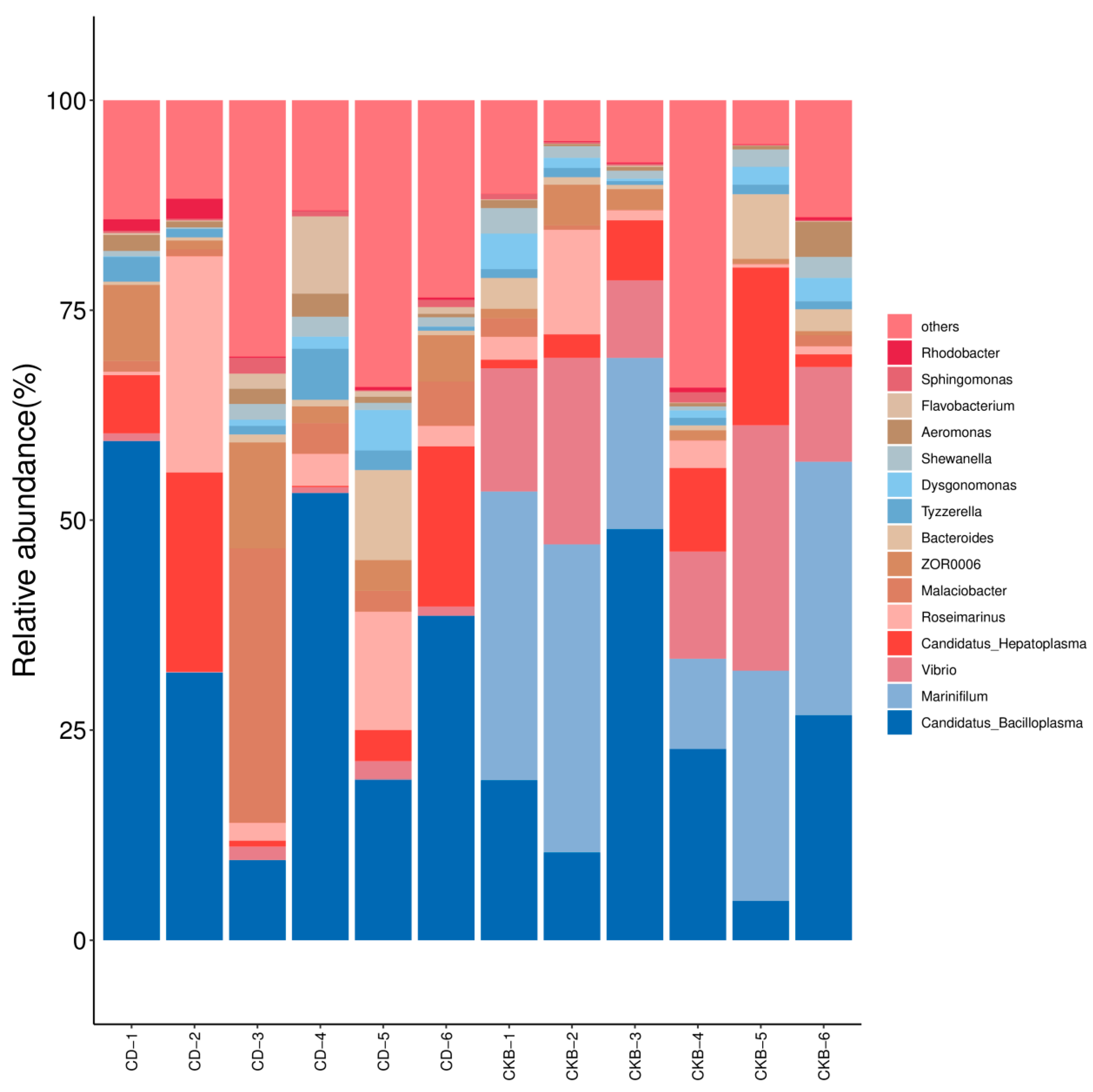
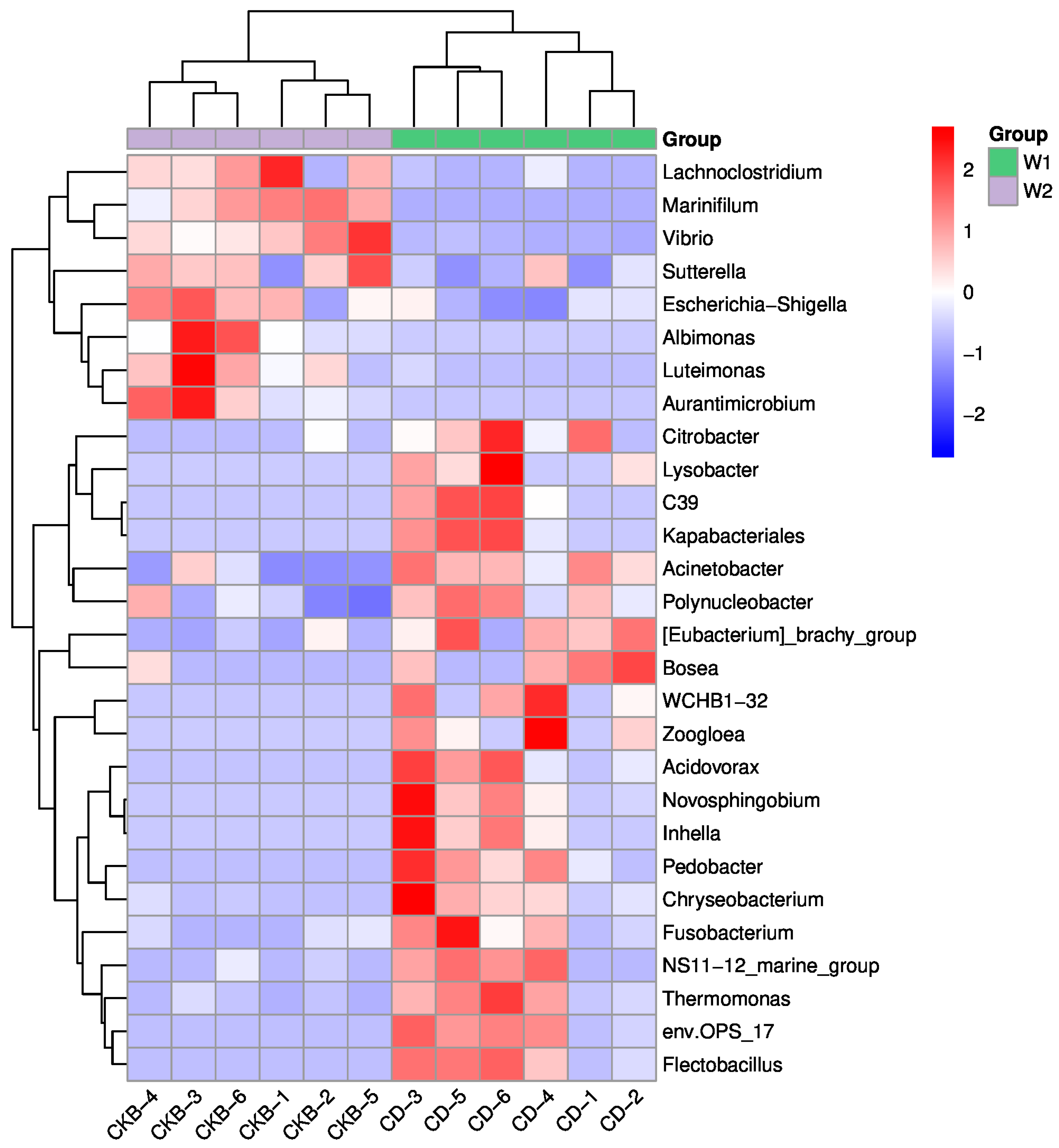
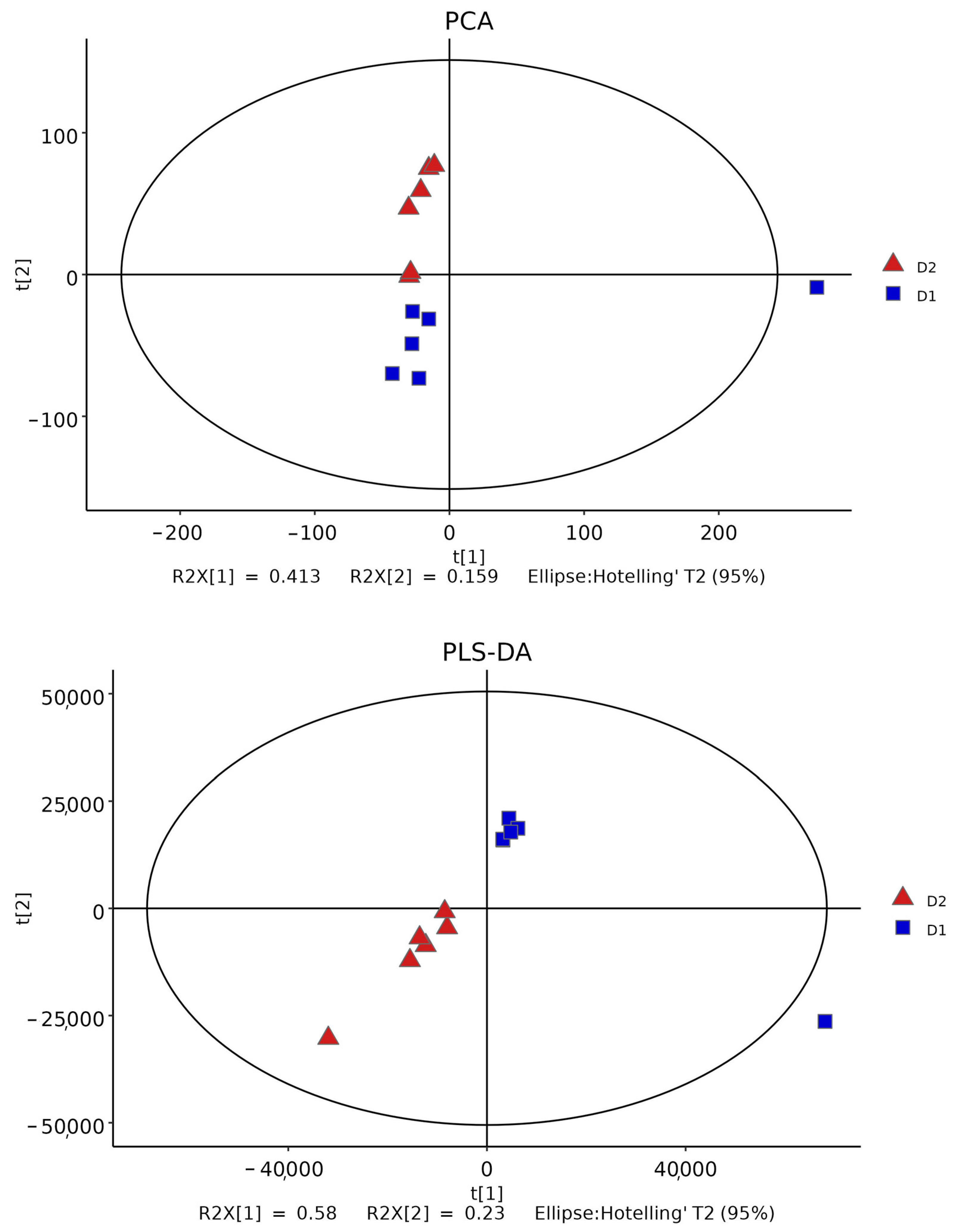
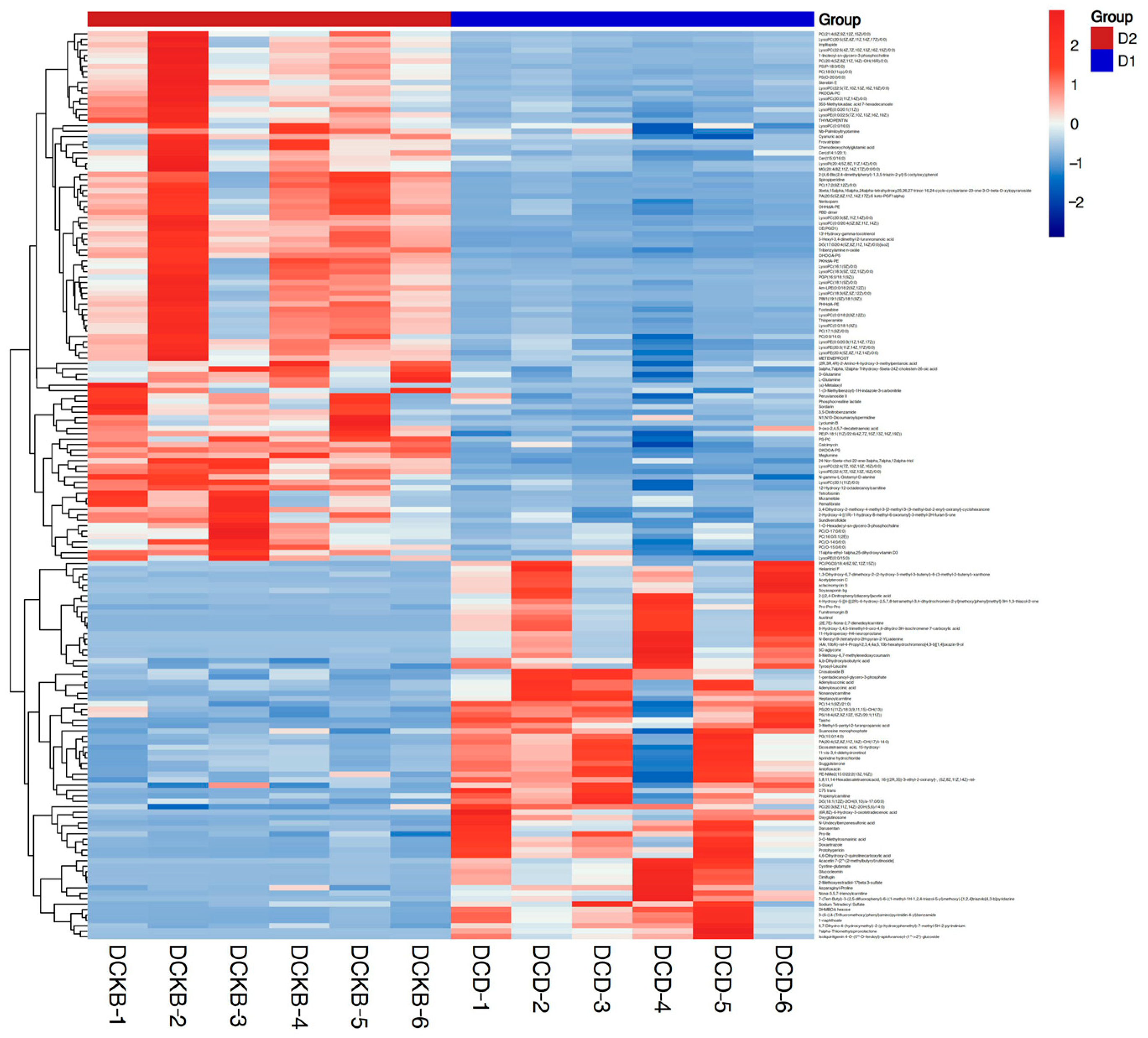
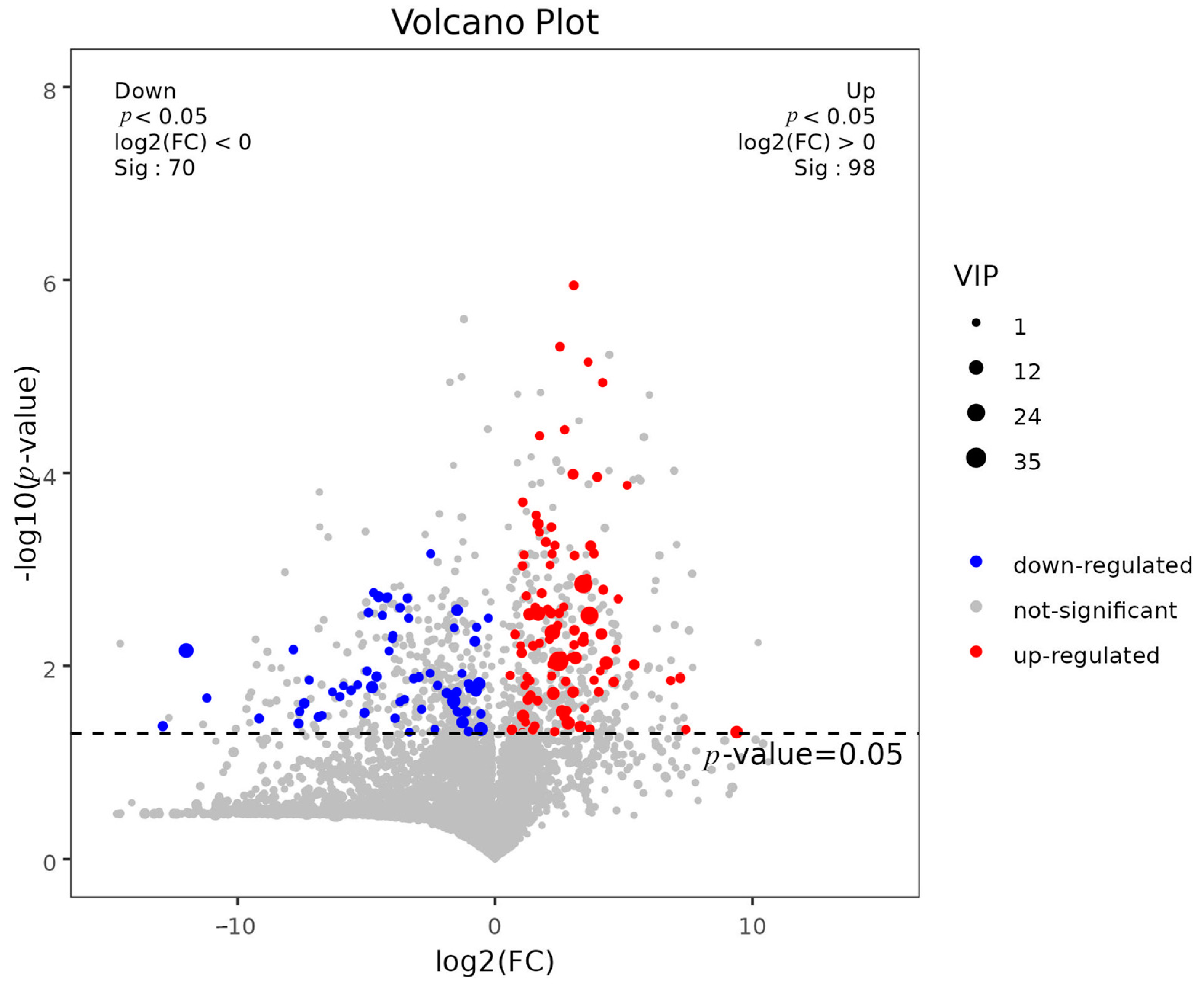
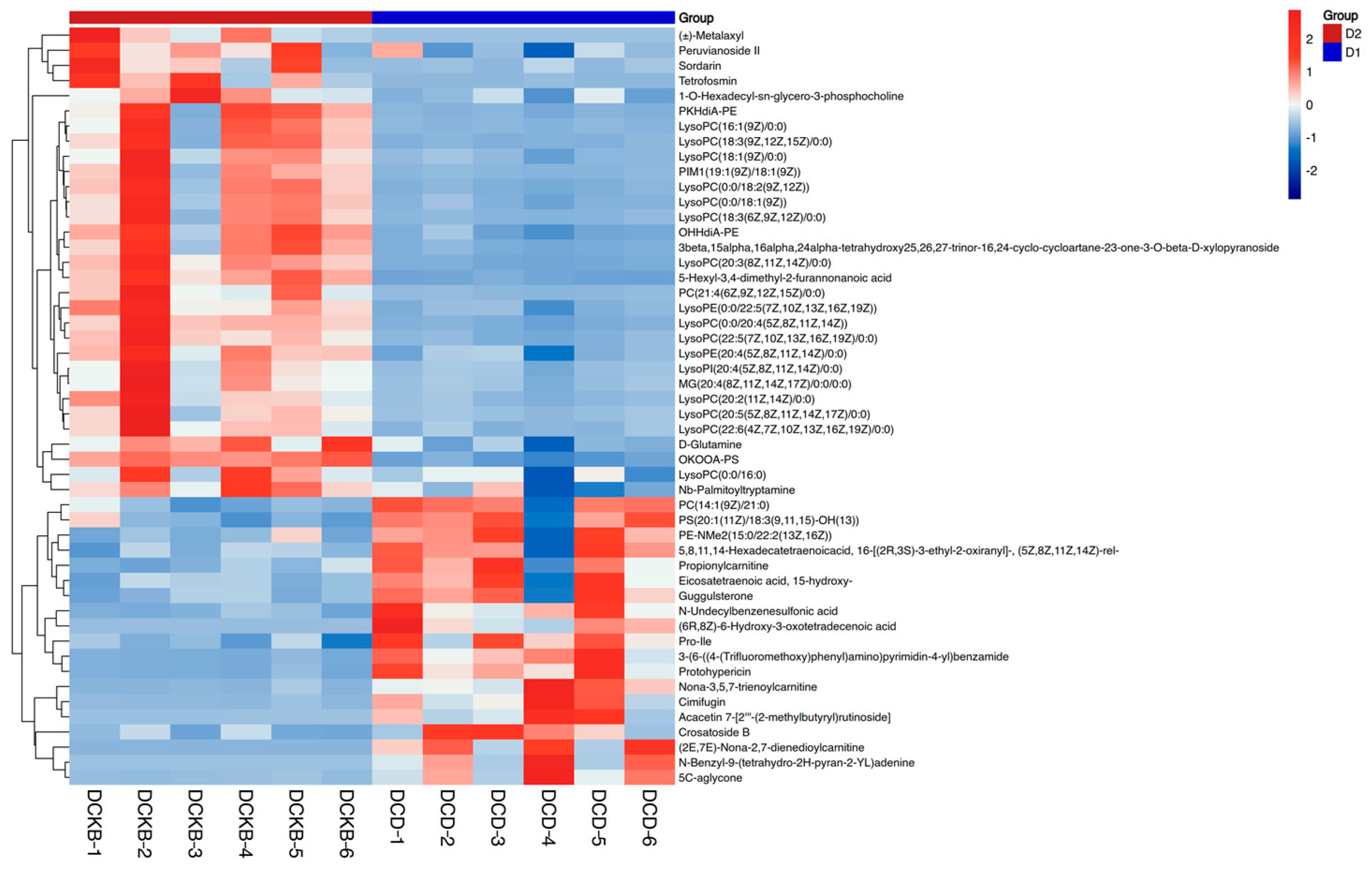

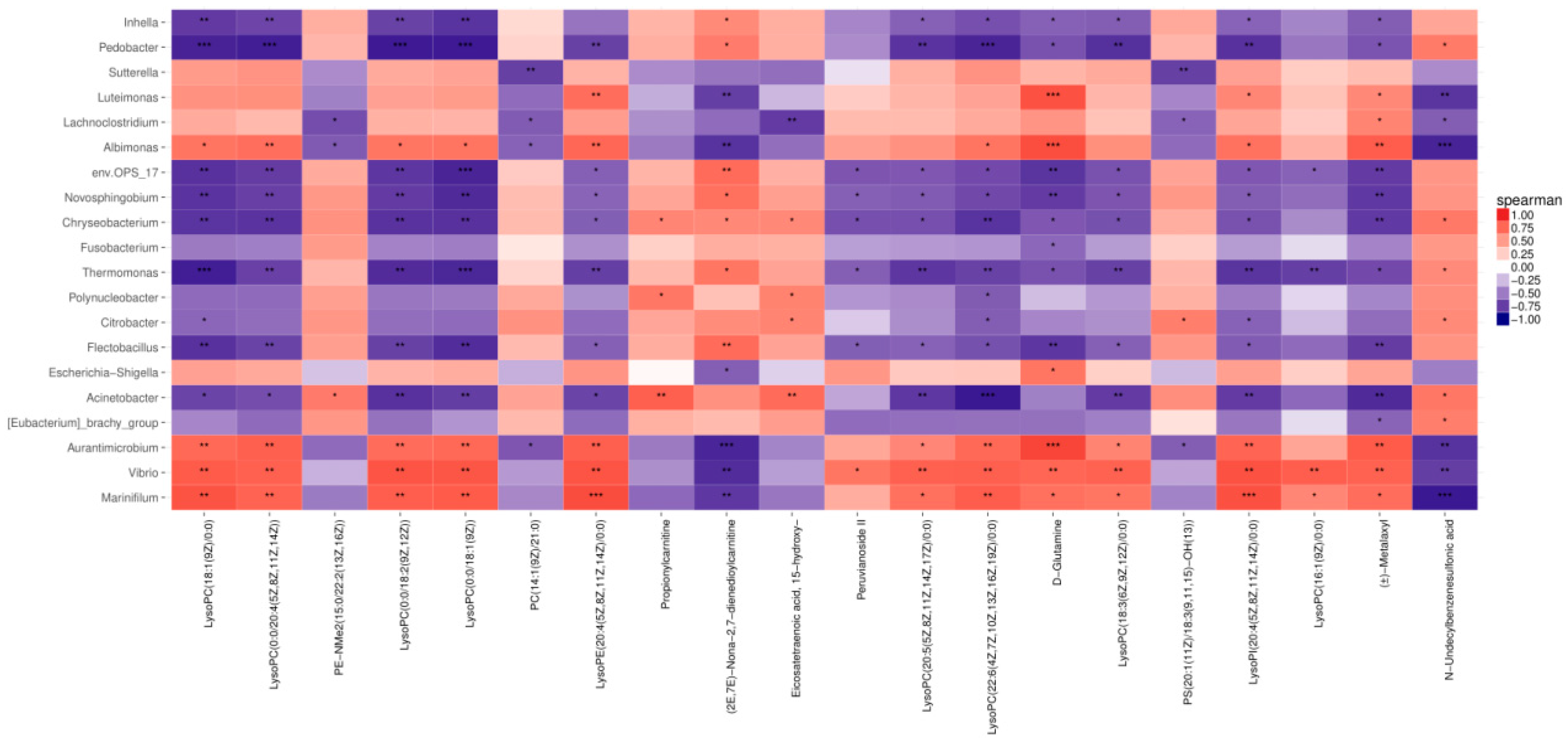
| Item | Control Group | 106 cfu/mL | 108 cfu/mL |
|---|---|---|---|
| CAT (U/mL) | 4.0119 ± 0.3165 a | 4.2685 ± 0.3923 a | 4.4195 ± 0.5387 a |
| GSH (U/mg) | 0.6802 ± 0.1658 a | 0.7851 ± 0.1148 b | 0.8446 ± 0.076 b |
| MDA (mU/mL) | 0.0296 ± 0.0147 a | 0.0266 ± 0.0081 a | 0.0124 ± 0.0057 b |
| SOD (U/mg) | 61.0360 ± 1.9820 a | 58.5744 ± 2.2518 b | 61.3155 ± 1.8405 a |
| T-AOC (U/mg) | 0.2385 ± 0.0182 a | 0.2086 ± 0.0357 a | 0.2409 ± 0.0526 a |
| Item | Control Group | 106 cfu/mL | 108 cfu/mL |
|---|---|---|---|
| CAT (U/mL) | 0.3475 ± 0.0444 a | 0.3630 ± 0.0418 a | 0.4294 ± 0.0715 b |
| GSH (U/mg) | 0.5940 ± 0.0607 a | 0.5791 ± 0.0386 a | 0.6530 ± 0.0179 b |
| MDA (mU/mL) | 0.4645 ± 0.3984 a | 0.4217 ± 0.1647 a | 0.4146 ± 0.1290 a |
| SOD (U/mg) | 16.8892 ± 11.8846 a | 15.8798 ± 4.4397 a | 17.6362 ± 3.9137 a |
| T-AOC (U/mg) | 0.0744 ± 0.0285 a | 0.0817 ± 0.0380 a | 0.1134 ± 0.0389 a |
| Item | Villus Length (μm) | Crypt Depth (μm) |
|---|---|---|
| control group | 154.19 ± 34.24 a | 61.91 ± 14.90 a |
| 106 cfu/mL | 189.24 ± 23.81 a | 76.52 ± 8.90 a |
| 108 cfu/mL | 214.13 ± 11.51 b | 104.24 ± 25.39 b |
| Sample-ID | Raw_Reads | Filtered | Percentage of Input Passed Filter | Goods_Coverage | ASV_Counts |
|---|---|---|---|---|---|
| CD-1 | 81,936 | 75,018 | 91.56 | 0.99997 | 138 |
| CD-2 | 80,091 | 77,197 | 96.39 | 0.999902 | 238 |
| CD-3 | 80,954 | 77,647 | 95.91 | 0.999859 | 394 |
| CD-4 | 80,971 | 76,959 | 95.05 | 0.99993 | 268 |
| CD-5 | 80,137 | 74,716 | 93.24 | 0.999894 | 222 |
| CD-6 | 78,815 | 75,950 | 96.36 | 0.999924 | 334 |
| CKB-1 | 80,713 | 62,144 | 76.99 | 1 | 119 |
| CKB-2 | 80,897 | 77,519 | 95.82 | 0.99992 | 184 |
| CKB-3 | 81,527 | 76,531 | 93.87 | 0.9999 | 170 |
| CKB-4 | 79,677 | 76,824 | 96.42 | 0.999893 | 274 |
| CKB-5 | 78,223 | 74,946 | 95.81 | 0.999928 | 138 |
| CKB-6 | 81,147 | 77,416 | 95.4 | 0.999906 | 242 |
| Concentration | Alpha Diversity Index | ||
|---|---|---|---|
| (CFU/g) | Ace | Chao | Shannon |
| 0 | 188.59 ± 59.54 a | 188.24 ± 59.87 a | 3.38 ± 0.46 a |
| 1 × 108 | 266.43 ± 89.66 a | 266.09 ± 89.68 a | 4.43 ± 0.27 b |
| Metabolites | VIP | p-Value | log2(FC) | FC | Trend |
|---|---|---|---|---|---|
| LysoPC (18:1(9Z)/0:0) | 32.861 | 0.00897 | 2.47068 | 5.54306 | ↑ ** |
| LysoPC (0:0/20:4(5Z,8Z,11Z,14Z)) | 26.4308 | 0.00142 | 3.42823 | 10.7646 | ↑ ** |
| LysoPC (0:0/18:2(9Z,12Z)) | 24.3984 | 0.00301 | 3.66833 | 12.7139 | ↑ ** |
| LysoPC (0:0/18:1(9Z)) | 15.3216 | 0.00448 | 2.23524 | 4.7084 | ↑ ** |
| (2E,7E)-Nona-2,7-dienedioylcarnitine | 13.108 | 0.00694 | −11.998 | 0.00024 | ↓ ** |
| LysoPE (20:4(5Z,8Z,11Z,14Z)/0:0) | 12.7626 | 0.00285 | 1.67581 | 3.19499 | ↑ ** |
| PE-NMe2 (15:0/22:2(13Z,16Z)) | 10.0736 | 0.04522 | −0.5477 | 0.68411 | ↓ * |
| Propionylcarnitine | 9.2894 | 0.02319 | −1.6108 | 0.32742 | ↓ * |
| LysoPC (18:3(6Z,9Z,12Z)/0:0) | 9.06324 | 0.00932 | 4.31848 | 19.9522 | ↑ ** |
| LysoPC (20:5(5Z,8Z,11Z,14Z,17Z)/0:0) | 8.99216 | 0.03905 | 2.84103 | 7.16533 | ↑ * |
| LysoPC (22:6(4Z,7Z,10Z,13Z,16Z,19Z)/0:0) | 7.70625 | 0.01928 | 2.26058 | 4.79186 | ↑ * |
| LysoPC (16:1(9Z)/0:0) | 7.68579 | 0.00828 | 3.12461 | 8.72169 | ↑ ** |
| PC (14:1(9Z)/21:0) | 7.64072 | 0.01529 | −0.622 | 0.64975 | ↓ * |
| LysoPI (20:4(5Z,8Z,11Z,14Z)/0:0) | 7.22517 | 0.02954 | 2.60313 | 6.07602 | ↑ * |
| Eicosatetraenoic acid, 15-hydroxy- | 6.98094 | 0.03844 | −1.2653 | 0.41602 | ↓ * |
Disclaimer/Publisher’s Note: The statements, opinions and data contained in all publications are solely those of the individual author(s) and contributor(s) and not of MDPI and/or the editor(s). MDPI and/or the editor(s) disclaim responsibility for any injury to people or property resulting from any ideas, methods, instructions or products referred to in the content. |
© 2023 by the authors. Licensee MDPI, Basel, Switzerland. This article is an open access article distributed under the terms and conditions of the Creative Commons Attribution (CC BY) license (https://creativecommons.org/licenses/by/4.0/).
Share and Cite
Gao, X.; Liu, X.; Wang, Y.; Wang, T.; Fang, D.; Hu, K. Effects of Clostridium butyricum on Intestinal Microflora and Metabolism of Eriocheir sinensis. Int. J. Mol. Sci. 2023, 24, 13784. https://doi.org/10.3390/ijms241813784
Gao X, Liu X, Wang Y, Wang T, Fang D, Hu K. Effects of Clostridium butyricum on Intestinal Microflora and Metabolism of Eriocheir sinensis. International Journal of Molecular Sciences. 2023; 24(18):13784. https://doi.org/10.3390/ijms241813784
Chicago/Turabian StyleGao, Xiaoning, Xueting Liu, Yali Wang, Tianwei Wang, Di Fang, and Kun Hu. 2023. "Effects of Clostridium butyricum on Intestinal Microflora and Metabolism of Eriocheir sinensis" International Journal of Molecular Sciences 24, no. 18: 13784. https://doi.org/10.3390/ijms241813784
APA StyleGao, X., Liu, X., Wang, Y., Wang, T., Fang, D., & Hu, K. (2023). Effects of Clostridium butyricum on Intestinal Microflora and Metabolism of Eriocheir sinensis. International Journal of Molecular Sciences, 24(18), 13784. https://doi.org/10.3390/ijms241813784





